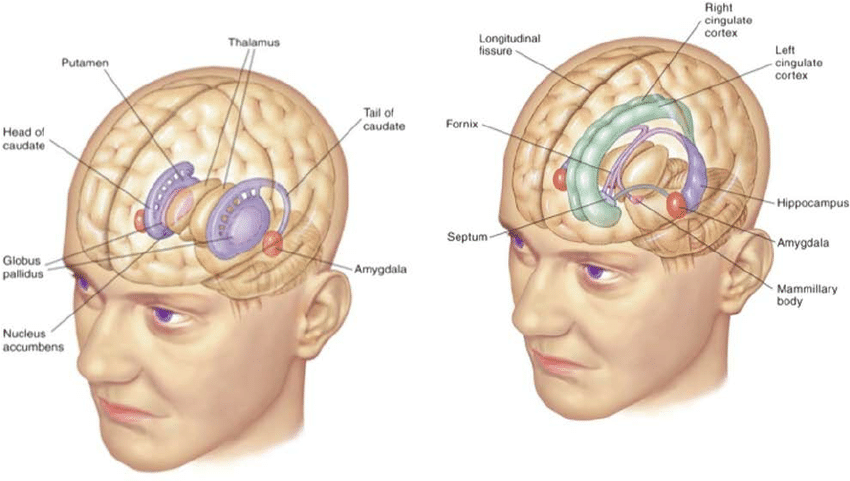Basal ganglia

The basal ganglia are a group of subcortical nuclei situated at the base of the forebrain and top of the midbrain. Basal ganglia are strongly interconnected with the cerebral cortex, thalamus, and brainstem, as well as several other brain areas. The basal ganglia are associated with a variety of functions, including control of voluntary motor movements, procedural learning, habit formation, conditioning, and others.
The main components of the basal ganglia—as defined functionally—are the dorsal stratum (caudate nucleus and putamen)and the ventral striatum (nucleus accumbens and olfactory tubercle) globus pallidus, ventral pallidum, substantia nigra, and the subthalamic nucleus. Each of these components has a complex internal anatomical and neurochemical organization. The largest component, the striatum (dorsal and ventral), receives input from many brain areas beyond the basal ganglia, but only sends output to other components of the basal ganglia. The globus pallidus receives input from the striatum, and sends inhibitory output to a number of motor-related areas. The substantia nigra is the source of the striatal input of the neurotransmitter dopamine, which plays an important role in basal ganglia function. The subthalamic nucleus receives input mainly from the striatum and cerebral cortex and projects to the globus pallidus.
Popular theories implicate the basal ganglia primarily in action selection—in helping to decide which of several possible behaviors to execute at any given time. In more specific terms, the basal ganglia’s primary function is likely to control and regulate activities of the motor and premotor cortical areas so that voluntary movements can be performed smoothly. It also plays a role in attention, acting as a sort of automatic transmission, subconsciously shifting attentional resources as the cortex demands. Experimental studies show that the basal ganglia exert an inhibitory influence on a number of motor systems, and that a release of this inhibition permits a motor system to become active. The “behavior switching” that takes place within the basal ganglia is influenced by signals from many parts of the brain, including the prefrontal cortex.1 It has also been hypothesized that the basal ganglia are not only responsible for motor action selection, but also for the selection of more cognitive actions. This is because thinking is the evolutionary internalization of physical movement.
The basal ganglia have a limbic sector which includes the nucleus accumbens, ventral pallidum, and ventral tegmental area. There is considerable evidence that this limbic part plays a central role in operant conditioning as well as cognition and frontal lobe functioning, via the mesolimbic pathway from the ventral tegmental area to the nucleus accumbens that uses the neurotransmitter dopamine. A number of highly addictive drugs, including cocaine, amphetamine, and nicotine, are thought to work by increasing the efficacy of this dopamine signal.
When faced with a tiger suddenly springing from the bushes, what should you do? Stand still, run to climb a tree, or make a dash for the river and hope the tiger can’t swim? The movement program chosen at this point might determine whether you get to pass your genes along to any offspring. Since movements are most effective when well learned or habitual, the basal ganglia are also very involved in habit formation. It is possible that this is mostly the case for the left basal ganglia, as novelty is handled by the right hemisphere, and is transferred to the left hemisphere as it becomes familiar. Certain habits appear to be formed through the interplay between two distinct basal ganglia pathways. One of these pathways is associative. It consciously collects information needed for reaching goals such as staying warm, finding food, finding a mate, and expressing oneself artistically. A second pathway is more automatic. This route takes those lessons learned from the first pathway and includes them in a repertoire of stored habits. These habits are then available to be called upon, when cued by a given situation.
Habits develop to help the brain conserve energy. Being involved in habits, the basal ganglia also assists in energy conservation in regards to learned behaviors. As we learn a behavior, our mental activity decreases. As the behavior becomes more and more automatic, we start thinking less and less. When we first started learning the behavior, our brain had to work at full power to make sense of all the new information. After a few days of performing the same behavior, we no longer have to think about it, and so the prefrontal cortex and the task-positive network go quiet. When a behavior is first learned, it requires a major dose of concentration. Eventually we can perform that task with hardly any thought. The routine occurs by habit. Once that habit starts unfolding, our default mode network is free to mindwander. We can perform habits even while the rest of the brain goes to sleep.
References
-
Weyhenmeyer, James A.; Gallman, Eve. A. (2007). Rapid Review of Neuroscience. Mosby Elsevier. p. 102.
-
Duhigg, Charles. (2012). The Power of Habit Chapter 1 The Habit Loop How Habits Work (EPub p. 27). New York, NY: Penguin Random House.
-
Gains, Jeffery. (2021). How Are Habits Formed? The Psychology of Habit Formation. PositivePsychology: https://positivepsychology.com/how-habits-are-formed/.
-
Haley, J., John. Hagerman, Eric. Spark Chapter 6. Attention Deficit (p. 178). New York, NY: Little Brown Spark.
Metadata
Type:🔵 Tags: Biology / Neuroscience / Anatomy / Neuroanatomy Status:☀️